Simulation of the engine and automobile driveability during a driving cycle
06. Február, 2013, Autor článku: Matej Juraj, Elektrotechnika
Ročník 6, číslo 2  Pridať príspevok
Pridať príspevok
![]() If it is necessary to determine the parameters driving the car during a specific driving cycle, needs to know the characteristics of the power unit, and the specific parameters of the vehicle driving cycle. If we know the characteristics of the vehicle and driving cycle, we can determine the course of fuel consumption, emissions output, depending on shifting gears while driving cycle and many others. We are able to optimize the technique of driving the automobile.
If it is necessary to determine the parameters driving the car during a specific driving cycle, needs to know the characteristics of the power unit, and the specific parameters of the vehicle driving cycle. If we know the characteristics of the vehicle and driving cycle, we can determine the course of fuel consumption, emissions output, depending on shifting gears while driving cycle and many others. We are able to optimize the technique of driving the automobile.
2. Driving forces calculation
Forces that must be overcome during driving a vehicle shall be equal to actual force of the driving wheels. Total force must therefore be equal to the force of the driving wheels, see equation (1). The same goes for vehicle’s power needed to overcome the driving forces. Vehicle’s power must be equal to power of the driving wheels and that must be equal to power of engine reduced by efficiency of transmission, see Equation (6).
As can be seen from equation (1), driving vehicle must overcome force of air, rolling, inertia and slope. These forces must be overcome by engine torque, the actual value of engine torque will vary depending on driving forces during driving cycle. In other words, what is the total road load power, so it must be the engine power through a gear ratio and transmission efficiency [1].
| (1) |
Where: Tengine – engine torgue (Nm), itotal – total gear ratio(-), ηtrans – efficiency of transmission (-), rd – Wheel dynamic radius (m), Fair – force of air (N), Frolling -force of tires rolling (N), Finertia – force of vehicle inertia, Fslope – force of slope road (N)
In order be able to calculate the total driving force and total driving power of which determine the engine power, we must calculate single running forces by means of the following equations (2), (3), (4), (5). Then we can calculate the actual fuel consumption during driving cycle.Calculation of driving forces:
Force of air
| (2) |
Where: S – frontal area of vehicle (m2), cx – drag coeficient (-), ρair – air density (kg/m3), v – vehicle speed (m/s)
Force of rolling
| (3) |
Where: m – vehicle mass (kg), g – gravity acceleration (m/s2), frolling – coefficient of rolling force (-), α – angle slope road (°)
Force of inertia
| (4) |
Where: a – vehicle acceleration (m/s2), ϑ – coefficient of inertia force (-)
Force of slope road calculated according to Equation (5), this force in our calculations are not considered because driving cycle in our simulation is without the slope road, and this force is equal to zero.
| (5) |
Once we have calculated all driving forces that must be overcome during the driving cycle, we can calculate the power required to overcome the driving forces and the required engine power, using the Equation (6).
| (6) |
If we calculated the engine power needed to overcome forces during driving cycle and know the engine map of brake specific fuel consumptions measured to a dynamometer, Figure 1, we can calculate the fuel consumption of driving vehicle, by equation (7) [2].
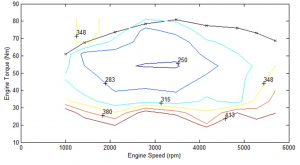
Figure 1: Maximum engine torque and brake specific fuel consumption
To calculate runway fuel consumption in liters per 100km is necessary to derive the relationship with specific fuel consumption in the following acts:
The resulting equation for the calculation of runway fuel consumption is:
| (7) |
Where: bsfc – brake specific fuel consumption (g/kW.h), Pengine – reguired engine power (kW), ρfuel – density of fuel (kg/m3), v – vehicle speed (km/h)
The calculated values should be applied to the driving cycle. Simulation to obtain the necessary amount of fuel injected every second of the driving cycle, and we will be able to optimize gear shifting and minimize the fuel consumption of the vehicle.
3. Required parameters of engine, vehicle and driving cycle
The simulation of a automobile during driving cycle is necessary to know the characteristics of the engine, vehicle and driving cycle. The next chapter focuses on the performance of the vehicle with a particular engine, the ride was simulated on a specific driving cycle.
3.1 Engine’s parameters
The following 4 figures are characterized an internal combustion engine. For our simulations, fuel consumption and emissions, it is sufficient to know the progress of torque, map of effective in a wide range of loads respectively map of the specific consumptions, emission production map CO, HC and NOx. On the figure 2 is a characteristic of the internal combustion engine provided with a map of efficiency. For a more accurate representation of the specific fuel consumption, we use the characteristics of the figure 1. In the area where the internal combustion engine a minimum specific consumption reaches a maximum overall efficiency, in this case 34%.
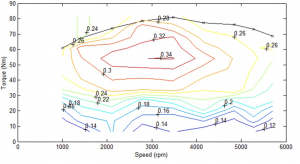
Figure 2: Engine efficiency characteritic
In order to simulate the process of production of emissions, it is necessary to know in addition to fuel consumption and emissions map of the internal combustion engine. Figures 3, 4, 5 define the internal combustion engine emissions. Figure 3 defines the course of production of CO throughout the load range of the internal combustion engine.
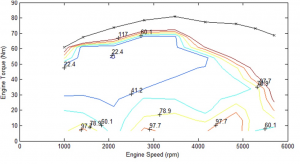
Figure 3: Engine CO characteristic
Figure 4 defines the course of production of HC emissions over the load range of the internal combustion engine.
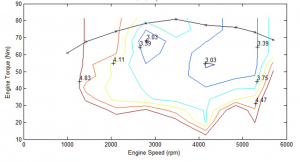
Figure 4: Engine HC characteristic
Figure 5 defines the course of production of NOx emissions over the load range of the internal combustion engine.
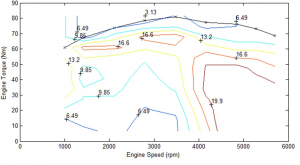
Figure 5: Engine NOx characteristic
Based on these characteristics, the combustion engine can determine the course of fuel consumption and emissions production process during the driving cycle.
3.2 Vehicle’s paramters
The next chapter presents the performance of the vehicle, which was running at the simulated NEDC driving cycle. This is an automobile with a combustion engine with an output 41 kW and a maximum total efficiency of 34%. Gross vehicle weight is 950 kg. The car has a 5-speed manual transmission. All the necessary parameters needed for the required simulations are shown in Table 1
Tab.1 Simulated vehicle parameters
| Maximum engine torque | Tengine | 100 | (Nm) | |
|---|---|---|---|---|
| Total gear ratio | itotal | 1st. gear | 13,8 | (-) |
| 2nd. gear | 8 | (-) | ||
| 3rd. gear | 5,3 | (-) | ||
| 4th. gear | 3,9 | (-) | ||
| 5th. gear | 3 | (-) | ||
| efficiency of transmission | ηtrans | 0,9 | (-) | |
| wheel dynamic radius | rd | 0,27 | (m) | |
| frontal area | S | 1,735 | (m2) | |
| drag coefficient | cx | 0,34 | (-) | |
| air density | ρair | 1,22 | (kg/m3) | |
| vehicle mass | m | 950 | (kg) | |
| coefficient of rolling force | frolling | 0,01 | (-) | |
| coefficient of rotating masses | ϑ | 1st. gear | 1,577 | (-) |
| 2nd. gear | 1,212 | (-) | ||
| 3rd. gear | 1,11 | (-) | ||
| 4th. gear | 1,072 | (-) | ||
| 5th. gear | 1,055 | (-) |
3.3 Driving cycle’s parameters
The course of the driving cycle (speed dependent on the time (s)) expresses Figure 6. It is a type of standardized driving cycle NEDC – New European Driving Cycle. The cycle is achieved precisely defined vehicle speed, gear shifting, acceleration, deceleration and off the clutch or in neutral. It includes urban, extra-urban and mixed driving. It is used to evaluate fuel consumption and emissions of european cars driving in the city, outside the city and in mixed traffic.
Next Figure 7 illustrates the percentage evaluation speed vehicle during NEDC driving cycle.
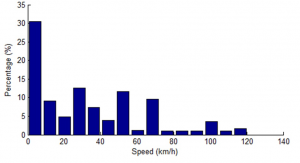
Figure 7: Automobile speed during driving cycle
Specifically, shifting gears according to NEDC driving cycle shown in Figure 8. Note that the NEDC cycle prescribes shifting gears and 5 and in urban traffic only 3 gears.

Figure 8: Shifting during driving cycle
Figure 9 illustrates the distance with respect to time during the driving cycle NEDC.

Figure 9: The course distance driving cycle
4 Simulations results
The next chapter presents the results of simulation driving operational characteristics of a particular vehicle for a specific driving cycle. Figure 10 shows the course of the traction forces on the driving wheels, which is necessary to achieve the driving cycle. Of these forces is calculated required power to drive the wheels, which we can see in Figure 11 Identifying and evaluating these within about Chapter 2 Driving forces calculation of this publication.

Figure 10: Force on driving vheels during driving cycle

Figure 11: Power on driving wheels during driving cycle
From the parameters of the vehicle and driving cycle, we can calculate the speed of the internal combustion engine at automobile speed on the driving cycle, depending on the gear ratio. From the calculation of the total wheel force we can calculate the required torque of the combustion engine needed to achieve the driving cycle. So if we recalculate the vehicle speed to engine speed and power necessary for the wheels of the engine torque, we get exactly the internal combustion engine operating points. If these points we draw up to operating characteristics of the internal combustion engine, so we can determine exactly what specific consumption internal combustion engine worked, and how effectively engine work and what is its actual emissions. Figure 12 shows the current operating points of the combustion engine in its characteristics. Figure 13 also includes shifting gears.
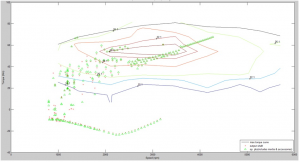
Figure 12: Engine operating points during driving cycle
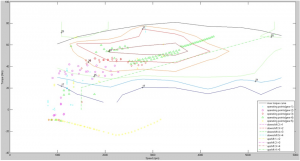
Figure 13: Engine operating points with shifting during driving cycle
From these operating points plotted in the engine characteristics (3.1 Engine’s parameters), we obtain efficiency of the combustion engine running, running fuel consumption and running CO, HC and NOx. Figure 14 shows the progress of the overall efficiency of the combustion engine when driving the car in the NEDC driving cycle.
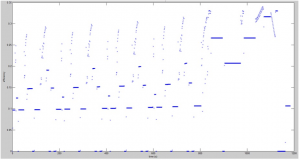
Figure 14: Engine eficiency during driving cycle
Figure 15 shows the running car’s fuel consumption during the driving cycle. This course is derived from the readings of specific fuel consumption characteristics of the internal combustion engine by drawing the current operating points during the driving cycle. In the same way we obtained the production process emissions in Figure 16. It was necessary to have the characteristics of an internal combustion engine with the production of emissions which drew currently operating points and the values subtracted.

Figure 15: Fuel consumption during driving cycle

Figure 16: Emision production during driving cycle
Conclusion
To determine these simulations, it was necessary to calculate the needs driving forces and performance on the driving wheels of car traveling in after a particular driving cycle. It was necessary to have the characteristics of an internal combustion engine with maps of specific fuel consumption, efficiency and emissions. It was necessary to calculate the vehicle speed to engine speed and calculate the necessary power to the wheels the engine torque during the driving cycle. Thus we obtain accurate combustion engine operating points that we portray to the specific characteristics of the internal combustion engine and so we obtained waveforms efficiency, fuel consumption and emissions of CO, HC and NOx in every second during the driving cycle.
In Figures 17 and 18 we can see the energy balance of the car and its parts during the driving cycle. Note that the highest energy achieved by an internal combustion engine. When decelerating, the car is a big part of the energy consumed in the friction brakes. This is also the reason for the use of hybrid drive vehicle, which govern the work of the internal combustion engine with an electric motor/generator and to maintain its efficiency at higher levels. When braking, use regenerative braking and energy consumption is so greatly reduced.
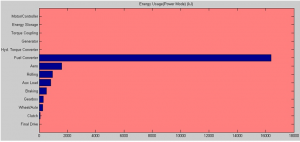
Figure 17: Energy usage in power mode
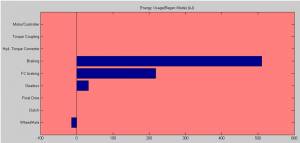
Figure 18: Energy usage in braking mode
References
- Vlk, F. Automobilová technická příručka, 1.vydanie, Brno 2003, ISBN 80-238-9681-4
- Madarás, J- Ferencey, V- Bugár, M. – Goga, V.: The
Simulation of Starting Torque Impact of an Electric Motor for the Dynamic
Behaviour of the Electric Vehicle Transmission Mechanism. In: Strojnícky časopis = Journal of Mechanical engineering. – Bratislava:
Ústav materiálov a mechaniky strojov SAV. – ISSN 0039-2472 – Roč. 63, č. 2. –, 2012, s. 83-94



12. Január, 2015 o 19:30
Hello.
I am engineering student and I am completing my thesis.
I wonder how have obtained the sfc map. I have test data but can not get the maps.
Thanks for any response.